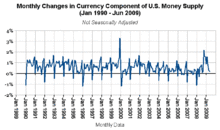 |
This is a file from the Wikimedia Commons. Information from its description page there is shown below.
Commons is a freely licensed media file repository. You can help.
|
 |
This image was uploaded in the JPEG format even though it consists of non-photographic data. This information could be stored more efficiently or accurately in the PNG format or SVG format. If possible, please upload a PNG or SVG version of this image without compression artifacts, derived from a non-JPEG source (or with existing artifacts removed). After doing so, please tag the JPEG version with {{ Superseded|NewImage.ext}}, and remove this tag. This tag should not be applied to photographs or scans. For more information, see {{ BadJPEG}}. |
|
|
Summary
| DescriptionMonthly Changes in Currency.jpg |
English: Monthly changes in the currency component of the U.S. money supply as reported by the Federal Reserve at the St. Louis Fed's F.R.E.D. website at: http://research.stlouisfed.org/fred2/data/CURRNS.txt The data was copy/pasted into an OpenOffice.org Calc spreadsheet, the monthly changes were calculated using a simple formula, then this image was generated from that data.
|
| Date |
20 December 2011 |
| Source |
Modified version of Monthly Changes in Currency Component of United States Money Supply.gif
|
| Author |
User: Analoguni |
Licensing
Belongs to public domain as non creative. Soerfm ( talk) 20:42, 20 December 2011 (UTC)
File usage
The following pages on Schools Wikipedia link to this image (list may be incomplete):
SOS Children's Villages has brought Wikipedia to the classroom. SOS Childrens Villages believes education is an important part of a child's life. That's why we ensure they receive nursery care as well as high-quality primary and secondary education. When they leave school, we support the children in our care as they progress to vocational training or higher education. Will you help another child today?



